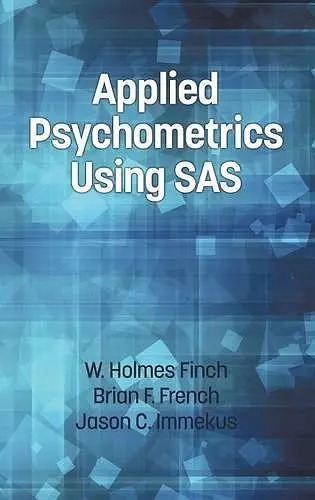Applied Psychometrics Using SAS
Holmes Finch author Brian F French author Jason C Immekus author
Format:Hardback
Publisher:Information Age Publishing
Published:24th Jun '14
Currently unavailable, and unfortunately no date known when it will be back
This hardback is available in another edition too:
- Paperback£45.00(9781623966942)

The book is designed primarily for graduate students (or advanced undergraduates) who are learning psychometrics, as well as professionals in the field who need a reference for use in their practice. We would assume that users have some basic knowledge of using SAS to read data and conduct basic analyses (e.g., descriptive statistics, frequency distributions). In addition, the reader should be familiar with basic statistical concepts such as descriptive statistics (e.g., mean, median, variance, standard deviation), percentiles and the rudiments of hypothesis testing. They should also have a passing familiarity with issues in psychometrics such as reliability, validity and test/survey scoring. The authors do not assume any more than basic familiarity with these issues, and devote a portion of each chapter (as well as the entire first chapter) to reviewing many of these basic ideas for those not familiar with them.
This book will be useful either as a primary text for a course on applied measurement where SAS is the main platform for instruction, or as a supplement to a more theoretical text. The readership will include graduate students, faculty members, data analysts and psychometricians responsible for analysis of survey response data, as well as educational and psychological assessments.
This book aims to provide readers with the tools necessary for assessing the psychometric qualities of educational and psychological measures as well as surveys and questionnaires. Each chapter covers an issue pertinent to psychometric and measurement practice, with an emphasis on application. Topics are briefly discussed from a theoretical/technical perspective in order to provide the reader with the background necessary to correctly use and interpret the statistical analyses that is presented subsequently. Readers are then presented with examples illustrating a particular concept (e.g., reliability). These examples include a discussion of the particular analysis, along with the SAS code necessary to conduct them. The resulting output is then discussed in detail, focusing on the interpretation of the results. Finally, examples of how these results might be written up is also included in the text. This mixture of theory with examples of actual practice will serve the reader both as a pedagogical tool and as a reference work.
ISBN: 9781623966959
Dimensions: unknown
Weight: unknown
278 pages